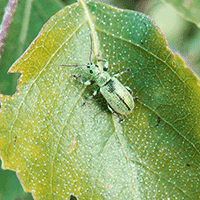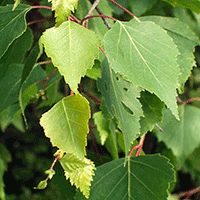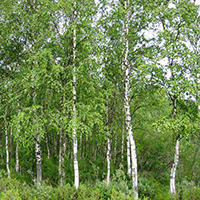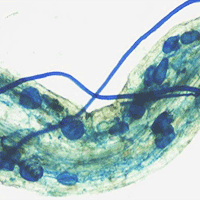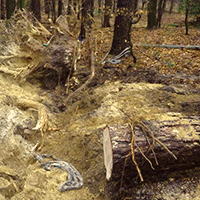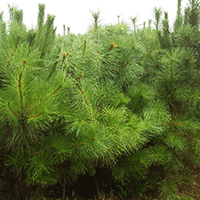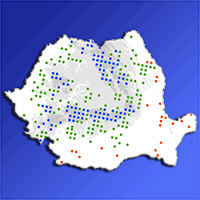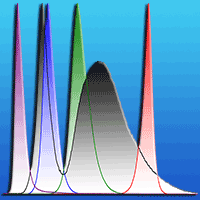The impact of leaf damage on the growth of young silver birch seedlings with and without additional nutrient supply was investigated by simulating leaf-insect damage and applying different levels (25%, 50% and 75%) of artificial defoliation. Based on field-practical and cost-effective methods, we determined how fertilization practices compensate for foliage loss, and the combined effect on silver birch seedling growth. The mineral fertilizers applied to the 25-75%-defoliated silver birch seedlings reduced the growth in aboveground biomass compared to the fertilized but undamaged seedlings. Our results showed that when the birch seedlings received more nutrients they did not compensate for the loss of foliar mass. However, the seedlings loosing part of their foliar mass and receiving no additional fertilizers did compensate for the foliage loss and their root growth was not weakened, using soil nutrients more effectively. Mineral fertilization up to optimal nutritional balance could be a beneficial tool for increasing growth rate and biomass accumulation in the short-term period. However, our study demonstrated that additional fertilization does not necessarily lead to growth compensation of partly defoliated young birch trees.
Keywords
, , , ,
Citation
Araminiene V, Varnagiryte-Kabašinskiene I, Stakenas V (2016). Response of artificially defoliated Betula pendula seedlings to additional soil nutrient supply. iForest 10: 281-287. - doi: 10.3832/ifor2086-009
Academic Editor
Gianfranco Minotta
Paper history
Received: Apr 12, 2016
Accepted: Nov 13, 2016
First online: Dec 13, 2016
Publication Date: Feb 28, 2017
Publication Time: 1.00 months
© SISEF - The Italian Society of Silviculture and Forest Ecology 2016
Open Access
This article is distributed under the terms of the Creative Commons Attribution-Non Commercial 4.0 International (https://creativecommons.org/licenses/by-nc/4.0/), which permits unrestricted use, distribution, and reproduction in any medium, provided you give appropriate credit to the original author(s) and the source, provide a link to the Creative Commons license, and indicate if changes were made.

Breakdown by View Type
(Waiting for server response...)
Article Usage
Total Article Views: 47204
(from publication date up to now)
Breakdown by View Type
HTML Page Views: 40515
Abstract Page Views: 2370
PDF Downloads: 3129
Citation/Reference Downloads: 48
XML Downloads: 1142
Web Metrics
Days since publication: 3274
Overall contacts: 47204
Avg. contacts per week: 100.92
Article Citations
Article citations are based on data periodically collected from the Clarivate Web of Science web site
(last update: Mar 2025)
Total number of cites (since 2017): 1
Average cites per year: 0.11
Publication Metrics
by Dimensions ©
Articles citing this article
List of the papers citing this article based on CrossRef Cited-by.
(1)
Anttonen S, Piispanen R, Ovaska J, Mutikainen P, Saranpää P, Vapaavuori E (2002)Effects of defoliation on growth, biomass allocation, and wood properties of
Betula pendula clones grown at different nutrient levels. Canadian Journal of Forest Research 32: 498-508.
CrossRef |
Gscholar
(2)
Boege K (2005)Influence of plant ontogeny on compensation to leaf damage. American Journal of Botany 92 (10): 1632-1640.
CrossRef |
Gscholar
(3)
Bonan GB, Shugart HH (1989)Environmental factors and ecological processes in boreal forests. Annual Reviews in Ecology and Systematics 20: 1-28.
CrossRef |
Gscholar
(4)
Brække FH, Håland B (1995)Above ground biomass and mineral element distribution in Scots pine stand of a virgin low-shrub pine bog. Communications of Skogforsk 47 (7): 17.
Gscholar
(5)
Broadmeadow MSJ, Jackson SB (2000)Growth responses of
Quercus petraea,
Fraxinus excelsior and
Pinus sylvestris to elevated carbon dioxide, ozone and water supply. New Phytologist 146: 437-451.
CrossRef |
Gscholar
(6)
Dobbertin M (2005)Tree growth as indicator of tree vitality and of tree reaction to environmental stress: a review. European Journal of Forest Research 124: 319-333.
CrossRef |
Gscholar
(7)
Erbilgin N, Galvez DA, Zhang B, Najaret A (2014)Resource availability and repeated defoliation mediate compensatory growth in trembling aspen (
Populus tremuloides) seedlings. PeerJ 2: e491.
CrossRef |
Gscholar
(8)
Eyles A, Pinkard EA, Mohammed C (2009)Shifts in biomass and resource allocation patterns following defoliation in
Eucalyptus globulus growing with varying water and nutrient supplies. Tree Physiology 29: 753-764.
CrossRef |
Gscholar
(9)
Ferm A, Hokkanen T, Moilanen M, Issakainen J (1992)Effects of wood bark ash on the growth and nutrition of Scots pine afforestation in central Finland. Plant and Soil 147: 305-316.
CrossRef |
Gscholar
(10)
Finér L (1992)Nutrient concentrations in
Pinus sylvestris on an ombrotrophic pine bog, and the effect of PK and NPK fertilization. Scandinavian Journal of Forest Research 7: 205-218.
CrossRef |
Gscholar
(11)
Galloway JN, Dentener FJ, Capone DG, Boyer EW, Howarth RW, Seitzinger SP, Asner GP, Cleveland CC, Green PA, Holland EA, Karl DM, Michaels AF, Porter JH, Townsend AR, Vöosmarty CJ (2004)Nitrogen cycles: past, present, and future. Biogeochemistry 70: 153-226.
CrossRef |
Gscholar
(12)
Hawkes CV, Sullivan JJ (2001)The impact of herbivory on plants in different resource conditions: a meta-analysis. Ecology 82: 2045-2058.
CrossRef |
Gscholar
(13)
Högberg P, Bengtsson G, Berggren D, Högberg M, Nilsson I, Nohrstedt H, Persson T, Sjöberg M (2000)How are the nitrogen dynamics of forest soils affected? In: “Effects of Nitrogen Deposition on Forest Ecosystems” (Bertills U, Näsholm T eds). Report no. 5067, Swedish Environmental Protection Agency, Berlings Skogs, Trelleborg, Sweden, pp. 29-53.
Gscholar
(14)
Houle G, Simard G (1996)Additive effects of genotype, nutrient availability and type of tissue damage on the compensatory response of
Salix planifolia ssp.
planifolia to simulated herbivory. Oecologia 107: 373-378.
CrossRef |
Gscholar
(15)
Huttunen L, Ayres MP, Niemelä P, Heiska S, Tegelberg R, Rousi M, Kellomäki S (2013)Interactive effects of defoliation and climate change on compensatory growth of silver birch seedlings. Silva Fennica 47 (3), article id 964, pp. 14.
CrossRef |
Gscholar
(16)
Huttunen L, Niemelä P, Ossipov V, Rousi M, Klemola T (2012)Do warmer growing seasons ameliorate the recovery of mountain birches after winter moth outbreak? Trees - Structure and Function 26: 809-819.
CrossRef |
Gscholar
(17)
Huttunen L, Niemelä P, Peltola H, Heiska S, Rousi M, Kellomäki S (2007)Is a defoliated silver birch seedling able to overcompensate the growth under changing climate? Environmental and Experimental Botany 60: 227-238.
CrossRef |
Gscholar
(18)
Hytönen J, Saramäki J, Niemistö P (2014)Growth, stem quality and nutritional status of
Betula pendula and
Betula pubescens in pure stands and mixtures. Scandinavian Journal of Forest Research 29 (1): 1-11.
CrossRef |
Gscholar
(19)
Jacquet JS, Bosc A, O’Grady A, Jactel H (2014)Combined effects of defoliation and water stress on pine growth and non-structural carbohydrates. Tree Physiology 34: 367-376.
CrossRef |
Gscholar
(20)
Kula E, Pešlová A, Martinek P (2012)Effects of nitrogen on growth properties and phenology of silver birch (
Betula pendula Roth). Journal of Forest Science 58: 391-399.
Online |
Gscholar
(21)
Mäkipää R, Karjalainen T, Pussinen A, Kellomäki S (1999)Effects of climate change and nitrogen deposition on the carbon sequestration of a forest ecosystem in the boreal zone. Canadian Journal of Forest Research 29: 1490-1501.
CrossRef |
Gscholar
(22)
Maschinski J, Whitham TG (1989)The continuum of plant-responses to herbivory - the influence of plant-association, nutrient availability, and timing. The American Naturalist 134: 1-19.
CrossRef |
Gscholar
(23)
Massad TJ (2013)Ontogenetic differences of herbivory on wood and herbaceous plants: a meta-analysis demonstrating unique effects of herbivory on the young and the old, the slow and the fast. Oecologia 172: 1-10.
CrossRef |
Gscholar
(24)
Meier ES, Lischke H, Schmatz DR, Zimmermann NE (2012)Climate, competition and connectivity affect future migration and ranges of European trees. Global Ecology and Biogeography 21: 164-178.
CrossRef |
Gscholar
(25)
Mutikainen P, Walls M, Ovaska J, Keinänen M, Julkunen-Tiitto R, Vapaavuori E (2000)Herbivore resistance in
Betula pendula: effect of fertilization, defoliation, and plant genotype. Ecology 81: 49-65.
CrossRef |
Gscholar
(26)
Niinemets U (2010)Responses of forest trees to single and multiple environmental stresses from seedlings to mature plants: past stress history, tolerance and acclimation. Forest Ecology and Management 260: 1623-1639.
CrossRef |
Gscholar
(27)
Nilsen P, Abrahamsen G (2003)Scots pine and Norway spruce stands responses to annual N, P and Mg fertilization. Forest Ecology and Management 174: 221-232.
CrossRef |
Gscholar
(28)
Ozolinčius R, Varnagiryte-Kabašinskiene I, Stakenas V, Mikšys V (2007)Effects of wood ash and nitrogen fertilization on Scots pine crown biomass. Biomass and Bioenergy 31: 700-709.
CrossRef |
Gscholar
(29)
Pinkard EA, Battaglia M, Mohammed CL (2007)Defoliation and nitrogen effects on photosynthesis and growth of
Eucalyptus globulus. Tree Physiology 27: 1053-1063.
CrossRef |
Gscholar
(30)
Pinkard EA, Battaglia M, Roxburgh S, O’Grady AP (2011)Estimating forest net primary production under changing climate: adding pests into the equation. Tree Physiology 31: 686-699.
CrossRef |
Gscholar
(31)
Reich PB, Walters MB, Krause SC, Vanderklein DW, Raffa KF, Tabone T (1993)Growth, nutrition and gas exchange of
Pinus resinosa following artificial defoliation. Trees 7: 67-77.
CrossRef |
Gscholar
(32)
Saarsalmi A, Mälkönen E (2001)Forest fertilization research in Finland: a literature review. Scandinavian Journal of Forest Research 16: 514-535.
CrossRef |
Gscholar
(33)
Stevens MT, Kruger EL, Lindroth RL (2008)Variation in tolerance to herbivory is mediated by differences in biomass allocation in aspen. Functional Ecology 22: 40-47.
CrossRef |
Gscholar
(34)
Tamm CO (1991)Nitrogen in terrestrial ecosystems. Ecology Studies 81, Springer-Verlag, Berlin, Germany, pp. 115.
Gscholar
(35)
Thelin G (2000)Nutrient imbalance in Norway spruce. PhD thesis, Lund University, Sweden, pp. 44.
Gscholar
(36)
Turnbull TL, Adams MA, Warren CR (2007)Increased photosynthesis following partial defoliation of field-grown
Eucalyptus globulus seedlings is not caused by increased leaf nitrogen. Tree Physiology 27: 1481-1492.
CrossRef |
Gscholar
(37)
Vanhellemont M, Van Acker J, Verheyen K (2016)Exploring life growth patterns in birch (
Betula pendula), Scandinavian Journal of Forest Research.
CrossRef |
Gscholar
(38)
Varnagiryte-Kabašinskiene I, Araminiene V, Stakenas V (2015)Effects of artificial defoliation and insect damage on the growth of
Betula pendula saplings. iForest - Biogeosciences and Forestry 9: 95-100.
CrossRef |
Gscholar
(39)
Vasechko GI (1983)An ecological approach to forest protection. Forest Ecology and Management 5: 133-168.
CrossRef |
Gscholar
(40)
Verburg PSJ (2005)Soil solution and extractable soil nitrogen response to climate change in two boreal forest ecosystems. Biology and Fertility of Soils 41: 257-261.
CrossRef |
Gscholar
(41)
Waring RH, Savage T, Cromack K, Rose C (1992)Thinning and nitrogen-fertilization in a grand fir stand infested with western spruce budworm. 4. An ecosystem management perspective. Forest Science 38: 275-286.
Online |
Gscholar
(42)
Wise MJ, Abrahamson WG (2005)Beyond the compensatory continuum: environmental resource levels and plant tolerance of herbivory. Oikos 109: 417-428.
CrossRef |
Gscholar
(43)
Zhang S, Dang QL, Yü X (2006)Nutrient and CO
2 elevation had synergistic effects on biomass production but not on biomass allocation of white birch seedlings. Forest Ecology and Management 234: 238-244.
CrossRef |
Gscholar
